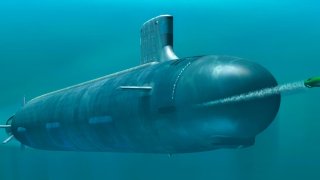One of The Newest Virginia-class Fast Attack Submarines is Set to be a Drone Carrier
The USS Delaware (SSN-791), a Virginia-class Block III fast-attack submarine, was commissioned in April 2022, becoming the first U.S. Naval warship to be commissioned while submerged due to the COVID-19 pandemic.
Summary and Key Points: The USS Delaware (SSN-791), a Virginia-class Block III fast-attack submarine, was commissioned in April 2022, becoming the first U.S. Naval warship to be commissioned while submerged due to the COVID-19 pandemic.

-This year, it will achieve another milestone by deploying a torpedo-tube launch-and-recovery (TTL&R) uncrewed underwater vehicle (UUV), making it the first operational submarine to do so.
-This deployment, planned for the European theater, enhances the submarine's mission capabilities, including defending critical undersea infrastructure. The REMUS 600 UUV, known as the "Yellow Moray," will enable the submarine to launch and recover drones via its torpedo tube, a significant advancement for the U.S. Navy.
Virginia-Class Submarine USS Delaware Leads Innovation in Underwater Drone Deployment
The United States Navy's Virginia-class Block III fast-attack submarine USS Delaware (SSN-791) was commissioned in April 2022. However, due to the COVID-19 pandemic, the official commissioning occurred while the boat was underway – "making it the first U.S. Naval warship to be commissioned while submerged," the U.S. Navy announced last summer following SSN-791's six-month maiden deployment.
USS Delaware could soon add another first to her accomplishments, as the U.S. Navy announced it will deploy a torpedo-tube launch-and-recovery (TTL&R) uncrewed underwater vehicle (UUV) capability on the Virginia-class boat later this year. SSN-791 will become the first operational submarine to operate with a TTL&R UUV, with the deployment planned to take place in the European theater of operations, NavalNews reported on Tuesday.
"We're going to install UUVs on a submarine, USS Delaware, starting in a couple of weeks, and they will deploy by the end of the year," Vice Admiral Rob Gaucher, commander of the United States Navy's Submarine Forces, told attendees at the Naval Leaders' Combined Naval Event 2024 (CNE 24) conference in Farnborough, UK, in May.
"We're already looking at who’s going to be next to start installing, so that we continuously have a submarine-operated vehicle," Gaucher continued.
Not a Yellow Submarine, Exactly
The U.S. Navy previously conducted tests of the Huntington Ingalls Industry's REMUS 600 UUV – which can exit and then re-enter a submerged submarine through its torpedo tube – on USS Delaware last year.
The REMUS medium UUV has been dubbed the "Yellow Moray."
"The Yellow Moray system will provide the U.S. submarine force with additional mission capability, enhancing what the U.S. Navy's submarines can provide to our nation's unified combatant commands around the globe," Submarine Readiness Squadron 32 announced via a post to Facebook in December.
Divers Not Required
According to a report from Maritime Executive, the ability to launch and recover an undersea drone via the torpedo tube is a significant advancement for the U.S. Navy's silent service. Previously, UUVs such as the REMUS 600 could only be deployed and recovered via a drydeck shelter, where divers would have to manually exit the submarine. The U.S. Navy has only so many submarines in service with dry decks, while the launch and recovery process was laborious.
The ability to launch and recover the UUV via the torpedo tube will make the drones usable across the entire submarine fleet. However, it will come with its own challenge – notably that an operator will have to thread a proverbial needle each time the drone needs to be recovered.
"While the submarine is moving, the UUV has to find that torpedo tube and drive in," the U.S. Navy's top submarine warfare officer Rear Admiral Doug Perry told USNI last year. "We expect in the very near future we will have that system operational."
The REMUS 600 – which is shaped like a standard torpedo – is around 10.6 feet long, 12.75 inches in diameter, and weighs 530 pounds. The battery-powered UUV can operate down to depths of 600 feet and is capable of semi-autonomous operation along a pre-defined route. It has a stated endurance of 70 hours.
Seabed Warfare
How exactly the UUVs could be deployed is still evolving, but it is expected to enhance the capabilities of the submarines, as the drones can operate at greater depths than human divers including on the seabed. The drones could be employed to defend and even attack critical infrastructure – notably undersea cables, which serve as vital communication links around the world. In addition, there are undersea gas pipelines that could be prime targets that need to be defended.

"Seabed warfare is a burgeoning area," said Gaucher, adding, "Everybody recognizes the need to defend our underwater infrastructure."
Author Experience and Expertise: Peter Suciu
Peter Suciu is a Michigan-based writer. He has contributed to more than four dozen magazines, newspapers, and websites with over 3,200 published pieces over a twenty-year career in journalism. He regularly writes about military hardware, firearms history, cybersecurity, politics, and international affairs. Peter is also a Contributing Writer for Forbes and Clearance Jobs. You can follow him on Twitter: @PeterSuciu. You can email the author: [email protected].
All images are Creative Commons.


